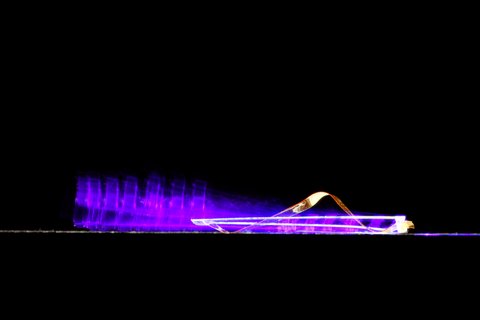Blog

World First New Polymer Goes for a Walk When Illuminated
Tech Geeks Created a New type of Polymer capable of “Walking” if it is lighted.
It looks like an idea taken from the movie “Flubber,” but scientists have managed to create a material that ripples and moves by itself when it is excited with light. The advance, made by scientists at the University of Kent (United States) and the Technical University of Eindhoven (The Netherlands), has been published in the journal Nature.
The device is the size of a clip and is composed of a polymer inserted in a rectangular frame. Thanks to its capabilities, it has become the first machine in the world capable of directly turning light into steps.
The small machine moves at the speed of a caterpillar, at about half a centimeter per second. But scientists believe it can be used to move small objects in inaccessible places or, for example, to keep the surface of solar panels clean. In fact, the researchers found that these small sheets are capable of removing grains of sand with their undulating motion, even when the particles weigh more than the machine itself.
The movement of the new material is achieved thanks to one side of the sheet contracting when it is illuminated by light, while the other part is not. The effect is that the material curls when it is illuminated and returns to its original position as soon as light disappears.

Polymer Walk forward and backward
This material is transparent, but actually absorbs all the violet light with which it is illuminated. Thanks to this detail, the very shrinkage of the material generates a shadow in other parts of the polymer. The result is that the machine acquires a constant undulating movement, whenever light is present.
A team of tech geeks from Kent State University and Eindhoven University of Technology, led by Dick Broer, have formulated a new polymer surefooted of wavelet and hence pushing progressive when incur a light stimulation. This little, clip-sized twist is the world’s first machine that bring off to turn light instantly into motion using only a rigid light source.
Obviously the maximum speed is not very high, barely half a centimeter per second, similar to that of a caterpillar. The movement of the new polymer is due to the fact that one of its sides contracts in reaction to light, and the other expands. This deformation in the polymer instantly disappears once the light source is turned off. Although the polymer seems transparent to the human eye, it completely absorbs the light used by the researchers, thus creating a shadow behind it.
According to the study, published in Nature, Broer’s team notes that it could be used to transport small items in places difficult to access or to keep the surface of solar cells clean. The mechanism is so powerful that it can even carry an object much larger and heavier than the device itself, uphill.
The experts used liquid crystal, similar to the LCD screens to build a framework in which incorporated a polymer sensitive to light. Thus the created material responds to the light deforming when one of its sides receives light and stretches instantaneously when the side that does not receive light extends.




